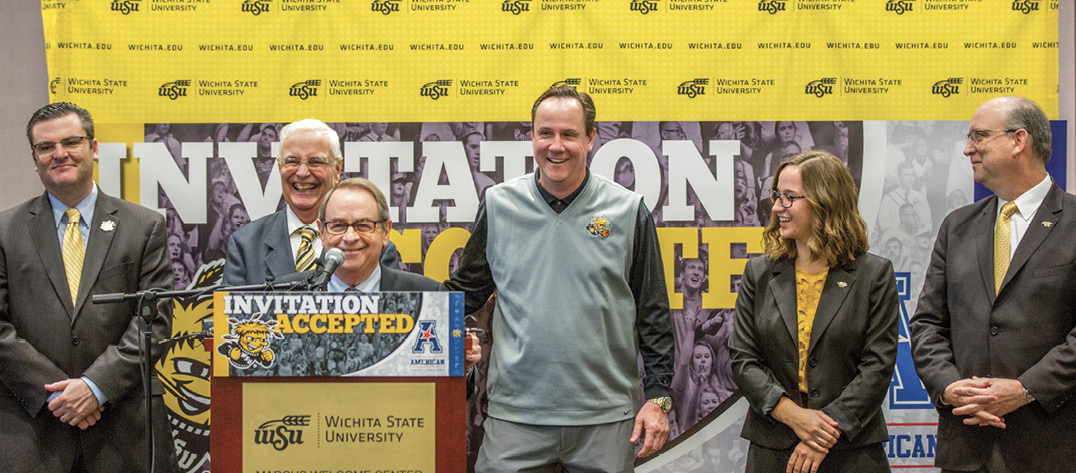
news conference on campus. The Shockers will compete as an AAC member in all sports except football, which
the university stopped playing in 1986.
Wichita State University President John Bardo shared the news on April 7: WSU has accepted the invitation from Commissioner Mike Aresco to join the American Athletic Conference, ending a 72-year relationship with the Missouri Valley Conference.
“This is an event of great importance in defining the future of Wichita State,” Bardo said. The new AAC affiliation begins July 1.
“We are pleased and proud to welcome Wichita State to The American,” Aresco said. “This is a university with a strong athletic and academic heritage, which shares our conference’s commitment to excellence, and we look forward to having them as a member. The university has an exceptionally strong tradition of success in men’s basketball and baseball. The addition of WSU in basketball and Olympic sports extends our conference’s national footprint, enhances our national profile and strengthens our position as a leader in intercollegiate athletics.”
The American holds media rights partnerships with ESPN and CBS Sports. In men’s basketball, the TV deal calls for all conference-controlled games to be televised, with more than 63 percent slotted for national broadcast or national cable – a minimum of 107 games.
The entire postseason tournament is televised, including the championship game, which is on ABC or ESPN. Sixty percent of the AAC’s women’s basketball games are carried on national cable, regional sports networks or ESPN3, while the conference has a multi-year agreement with CBS Sports Network for coverage of select baseball games.
The presidents of the AAC’s 12 member schools voted unanimously to admit Wichita State in all sports except football. Navy is an AAC football-only school.
Aresco acknowledged that the addition of the Shockers is likely to strengthen the conference’s upcoming negotiations for a new national TV deal. Its current contracts with ESPN run out after the 2019 football season and 2019-2020 basketball campaigns. The move is also expected to help both the conference and the Shockers when it comes to seeding in basketball for the NCAA tournament.
Our players “want to play the best,” WSU basketball coach Gregg Marshall said. “They want to compete against the best, because they ultimately want to be the best. So this will be a welcome change for us.”
Wichita State Athletic Director Darron Boatright reported that the student athletes, coaches and fans with whom he has spoken are excited about the coming move. “This gives us an opportunity to regularly test ourselves against traditionally strong competition – and to do so on a grander stage,” Boatright said.
Bardo and Boatright both expressed appreciation to the MVC and Commissioner Doug Elgin. “Doug and my athletic director colleagues have been gracious and understanding about our departure,” Boatright said. “We wish the Missouri Valley all the best.”
Bardo emphasized that joining the AAC is about more than improving Wichita State’s athletic standing. The move will help WSU improve academics by making new connections with other top research universities. Bardo also said that any thoughts of WSU’s returning to football have been put on a back burner with the decision to join The American. “This is as big a deal as we could possibly have had, and now is the time to focus on it,” he said.
Even before the invitation for Wichita State to join The American was issued, Commissioner Aresco was bullish on the AAC’s future, saying, “In two years, we’ll be among the best conferences in the country. “I’m totally convinced.”

Conference Standings By R&D Expenditures
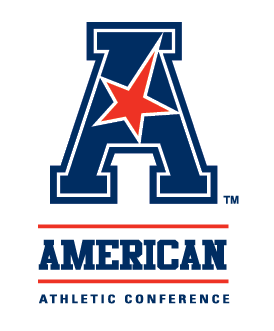
Wichita State’s move to the American Athletic Conference isn’t just about athletics, of course. WSU top administrators see the change in conference as a positive move in helping strengthen the university’s position as an innovative academic and research institution.
Like Wichita State, AAC universities are located in or near large metropolitan areas and play vital roles as regional economic engines, creating jobs and providing a skilled workforce.
Wichita State’s standing at the top of Missouri Valley Conference universities in terms of research falls right into the middle of AAC institutions, giving WSU an extra push to aim higher in athletics, absolutely, but also in academics and research.
Here are the numbers for AAC universities in nonmedical research and development expenditures:
1. University of South Florida, $190.3M
2. University of Central Florida, $188.6M
3. University of Houston, $150.6M
4. University of Connecticut, $115.8M
5. University of Cincinnati, $88.9M
6. Wichita State University, $59.9M
7. Temple University, $58.4M
8. University of Memphis, $46.6M
9. Tulane University, $34.8M
10. Southern Methodist University, $29.2M
11. East Carolina University, $26.5M
12. University of Tulsa $25M
The American Athletic Conference, which serves its membership from offices located in Providence, R.I., consists of these 12 institutions:
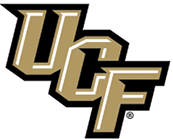 University of Central Florida, founded in 1963, is a public research university in Orlando. With a student body of 64,318 (2016), UCF is the largest university in the United States by undergraduate and total enrollment. UCF is home to the Knights, and its mascot is named Knightro.
University of Central Florida, founded in 1963, is a public research university in Orlando. With a student body of 64,318 (2016), UCF is the largest university in the United States by undergraduate and total enrollment. UCF is home to the Knights, and its mascot is named Knightro.

University of Cincinnati, founded in 1819, is a public research university in Cincinnati, Ohio. As the largest employer in its region, UC’s economic impact is listed as $4 billion. The Cincinnati Bearcats, a past member of the Missouri Valley Conference, are old rivals of the Shockers, going back to include fierce battles on the gridiron.
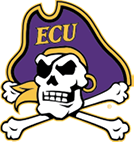
East Carolina University, which was founded in 1907 as a teacher training school, is a public doctoral/research university in Greenville, N.C. East Carolina is designated as a Sea Grant university and an Innovation and Economic Prosperity campus. Home to the Pirates, ECU’s mascot is PeeDee the Pirate. ECU joined the AAC on July 1, 2014.
 University of Connecticut, founded in 1881 as the Storrs Agricultural School, is a public research university in Storrs that now has 17 schools and colleges. UConn is home to the Huskies. Its mascot is Jonathan the Husky. In 2014, three UConn teams won national championship titles: field hockey and men’s and women’s basketball.
University of Connecticut, founded in 1881 as the Storrs Agricultural School, is a public research university in Storrs that now has 17 schools and colleges. UConn is home to the Huskies. Its mascot is Jonathan the Husky. In 2014, three UConn teams won national championship titles: field hockey and men’s and women’s basketball.
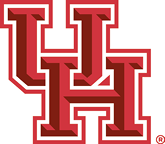 University of Houston, founded in 1927, is a Carnegie Tier One state research university and the third-largest university in Texas. Home to the Cougars, UH students, alumni and fans band together as Coog Nation. Their mascot is Shasta VI, a live cougar adopted by the school in 2012 in partnership with the Houston Zoo.
University of Houston, founded in 1927, is a Carnegie Tier One state research university and the third-largest university in Texas. Home to the Cougars, UH students, alumni and fans band together as Coog Nation. Their mascot is Shasta VI, a live cougar adopted by the school in 2012 in partnership with the Houston Zoo.
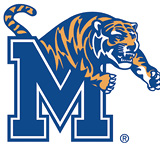 University of Memphis, founded in 1912, is a public research university located in the Normal Station neighborhood of Memphis. The UofM is a charter member of the AAC. The Memphis Tigers have a live mascot, a Bengal tiger named Tom III, as well as a costumed mascot called Pouncer.
University of Memphis, founded in 1912, is a public research university located in the Normal Station neighborhood of Memphis. The UofM is a charter member of the AAC. The Memphis Tigers have a live mascot, a Bengal tiger named Tom III, as well as a costumed mascot called Pouncer.
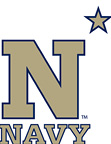 United States Naval Academy, established in 1845, is a four-year coeducational federal service academy in Annapolis, Md. Navy is a football-only member of The American. Navy’s other sports compete in The Patriot League. The Midshipmen played their first season in 1879 and won the national title in 1926. Their mascot is Bill the Goat.
United States Naval Academy, established in 1845, is a four-year coeducational federal service academy in Annapolis, Md. Navy is a football-only member of The American. Navy’s other sports compete in The Patriot League. The Midshipmen played their first season in 1879 and won the national title in 1926. Their mascot is Bill the Goat.
 University of South Florida, founded in 1956, is a public research university in Tampa. Originally the “Golden Brahman,” USF’s sports teams are today just known as the Bulls. Their mascot is named Rocky the Bull, and USF’s marching band goes by The Stampeding Herd of Thunder.
University of South Florida, founded in 1956, is a public research university in Tampa. Originally the “Golden Brahman,” USF’s sports teams are today just known as the Bulls. Their mascot is named Rocky the Bull, and USF’s marching band goes by The Stampeding Herd of Thunder.
![]() Southern Methodist University, founded in 1911, is a private research university in Dallas. The SMU Mustangs have both live (a black Shetland pony) and costumed mascots named Peruna.
Southern Methodist University, founded in 1911, is a private research university in Dallas. The SMU Mustangs have both live (a black Shetland pony) and costumed mascots named Peruna.
 Temple University, founded in 1884, is a state-related public doctoral university in Philadelphia, Pa. The traditional symbol of the university is the Temple “T.” The Temple Owls have a live mascot, a great horned owl named Stella (who has a boyfriend named Sherlock), and a costumed mascot called Hooter.
Temple University, founded in 1884, is a state-related public doctoral university in Philadelphia, Pa. The traditional symbol of the university is the Temple “T.” The Temple Owls have a live mascot, a great horned owl named Stella (who has a boyfriend named Sherlock), and a costumed mascot called Hooter.
.png) Tulane University, which was founded in 1834 as a public medical college, is a private research university in New Orleans. Its athletic teams were early on known as the Olive and Blue, but by 1920 the nickname the Green Wave had caught on. Tulane’s mascot is a pelican named Riptide by a vote of the student body in 1998.
Tulane University, which was founded in 1834 as a public medical college, is a private research university in New Orleans. Its athletic teams were early on known as the Olive and Blue, but by 1920 the nickname the Green Wave had caught on. Tulane’s mascot is a pelican named Riptide by a vote of the student body in 1998.
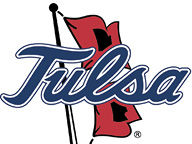 University of Tulsa, founded in 1894, is a private research university in Tulsa, Okla. The Golden Hurricane, a past MVC member, and the Shockers already share some sports history. Tulsa’s sports mascot is Captain ’Cane.
University of Tulsa, founded in 1894, is a private research university in Tulsa, Okla. The Golden Hurricane, a past MVC member, and the Shockers already share some sports history. Tulsa’s sports mascot is Captain ’Cane.





